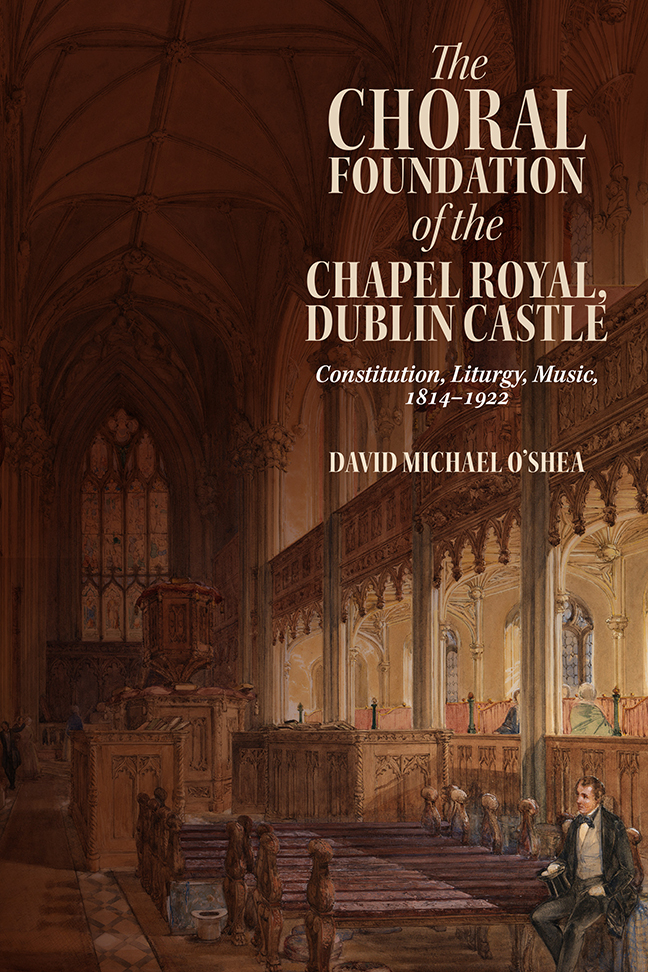Book contents
- Frontmatter
- Contents
- Illustrations
- Foreword
- Preface
- Acknowledgements
- A Note on Terminology
- Abbreviations
- Introduction
- 1 Precedents, Polity and Politics
- 2 Clergy
- 3 Churchmanship, Furnishings and Functions
- 4 The Musical Foundation
- 5 The Chapel Royal Music Collection
- 6 Singing the Liturgy
- 7 Organs
- 8 Boy Choristers
- 9 Gentleman Singers
- 10 Organists and Composers
- 11 The Chapel Royal's Legacy
- Conclusion
- Appendix A Lords Lieutenant, 1801–1922
- Appendix B Clergy of the Chapel Royal
- Appendix C Extant Chapel Royal Music Volumes (RCB MS 1113)
- Appendix D Boy Choristers of the Chapel Royal
- Appendix E Gentlemen Singers of the Chapel Royal
- Appendix F Organists of the Chapel Royal
- Appendix G Fragment of a Juvenile Chant by C. V. Stanford
- Bibliography
- Index
- Irish Musical Studies Previous volumes
- Frontmatter
- Contents
- Illustrations
- Foreword
- Preface
- Acknowledgements
- A Note on Terminology
- Abbreviations
- Introduction
- 1 Precedents, Polity and Politics
- 2 Clergy
- 3 Churchmanship, Furnishings and Functions
- 4 The Musical Foundation
- 5 The Chapel Royal Music Collection
- 6 Singing the Liturgy
- 7 Organs
- 8 Boy Choristers
- 9 Gentleman Singers
- 10 Organists and Composers
- 11 The Chapel Royal's Legacy
- Conclusion
- Appendix A Lords Lieutenant, 1801–1922
- Appendix B Clergy of the Chapel Royal
- Appendix C Extant Chapel Royal Music Volumes (RCB MS 1113)
- Appendix D Boy Choristers of the Chapel Royal
- Appendix E Gentlemen Singers of the Chapel Royal
- Appendix F Organists of the Chapel Royal
- Appendix G Fragment of a Juvenile Chant by C. V. Stanford
- Bibliography
- Index
- Irish Musical Studies Previous volumes
Summary
Historical overview
The chapel of Dublin Castle, the so-called Chapel Royal, was built between 1807 and 1814 to serve as the household chapel of the Lord Lieutenant, the chief governor of Ireland and representative of the British monarch. The new Chapel, which replaced an earlier one on the same site, was constituted differently from its predecessor: it was a choral foundation, and included a Dean and Sub-Dean, a college of honorary chaplains to the Lord Lieutenant, an organist and choirmaster, singing men, and boy choristers. This foundation regularly performed the choral service until it was disbanded following the abolition of the Lord Lieutenancy and the closure of the Chapel at the end of 1922.
As we shall see, the choral foundation of the Chapel was consciously modelled on the Chapel Royal of St James's Palace in London. The Dublin Chapel was unique in Ireland as the only ecclesiastical entity under the direct control of the Lord Lieutenant; thus it enjoyed a status analogous to English royal peculiars like Westminster Abbey and St George's Chapel, Windsor, in which the monarch was the ordinary. Although the Chapel was not the only ecclesiastical establishment paid for by government funds, it was the only one in which the government had direct influence on the liturgy. Music and liturgy at the Chapel were shaped by the tastes of successive Lords Lieutenant and the clergymen and musicians they appointed, and so the Chapel's musical and liturgical history is one of direct interface between church and state.
Dublin Castle, originally a medieval fortress, had been the seat of the Irish government and the residence of the English monarch's viceroy since the thirteenth century. This viceroy, who from the eighteenth century was invariably called Lord Lieutenant, was the figurehead of the viceregal court. After the Act of Union of 1800 abolished the Irish Parliament, the Lord Lieutenant presided over an unelected and unaccountable cabinet of officials appointed by the British government of the day. Although Irish members were elected to the Westminster parliament (by an increased franchise after Catholic Emancipation in 1829), the executive power held by the Dublin Castle administration created a sense of disenfranchisement in Ireland, and the quasi-colonial system of government was criticized by both supporters and opponents of the Union. The outspoken Liberal Unionist Joseph Chamberlain considered the Dublin Castle government to be ‘an absurd and irritating anachronism’.
- Type
- Chapter
- Information
- The Choral Foundation of the Chapel Royal, Dublin CastleConstitution, Liturgy, Music, 1814-1922, pp. 1 - 13Publisher: Boydell & BrewerPrint publication year: 2023

